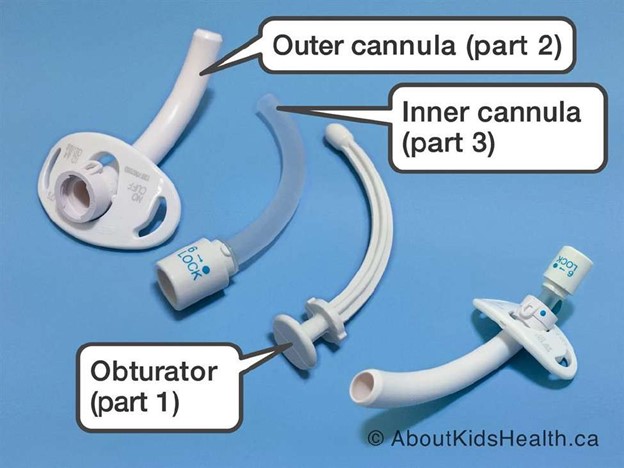A nurse is preparing a room for a client who has a tracheostomy tube. Which of following supplies should the nurse place in the room?
Povidone-iodine.
Obturator.
Irrigation set.
Hemostats.
The Correct Answer is B
Obturator.

An obturator is a device that is inserted into the tracheostomy tube to guide it through the stoma and prevent tissue damage. It should be removed after the tube is inserted and kept near the bedside in case of accidental decannulation.
Choice A is wrong because povidone-iodine is an antiseptic solution that is not routinely used for tracheostomy care. It can cause skin irritation and damage to the mucous membranes.
Choice C is wrong because an irrigation set is not needed for a tracheostomy tube.
Irrigation can introduce bacteria and increase the risk of infection. It can also cause coughing and bleeding.
Choice D is wrong because hemostats are not used for a tracheostomy tube.
Hemostats are surgical instruments that are used to clamp blood vessels or tissues. They have no role in tracheostomy care.
Some other supplies that the nurse should place in the room are a trach tube the same size as the current tube and one size smaller, a portable suction machine with battery backup, and tubing that connects to the suction machine. Other supplies may include saline solution, syringes, gauze squares, gloves, a trachea tube brush, a waterproof drape, non-woven sponges, pipe cleaners, cotton tipped applicators, a T-drain sponge, twill tape, a trach holder, a speaking valve, a stoma cover, and a nebulizer.
Nursing Test Bank
Naxlex Comprehensive Predictor Exams
Related Questions
Correct Answer is B
Explanation
This is because the client has hypothyroidism, which means their thyroid gland does not produce enough thyroid hormone. Levothyroxine is a synthetic form of thyroid hormone that can replace the missing hormone and normalize the TSH level. The client’s TSH level is 8.9 mIU/L, which is above the normal range of 0.4 to 4.0 mIU/L. This indicates that the client’s current dosage of levothyroxine is insufficient and needs to be increased.
Choice A is wrong because thyroid ablation therapy is a treatment for hyperthyroidism, not hypothyroidism.
Thyroid ablation therapy involves destroying part or all of the thyroid gland with radioactive iodine or surgery, which reduces the production of thyroid hormone.
This would worsen the client’s condition and symptoms.
Choice C is wrong because lovastatin is a statin drug that lowers cholesterol levels. Hypothyroidism can cause high cholesterol levels, but this is usually corrected by levothyroxine therapy. Replacing lovastatin with cholestyramine, a bile acid sequestrant that also lowers cholesterol levels, would not address the underlying cause of hypothyroidism and would not improve the client’s TSH level.
Choice D is wrong because restricting the intake of iodized salt would not help the client with hypothyroidism. Iodine is an essential element for the synthesis of thyroid hormone, but most people in developed countries get enough iodine from their diet.
Hypothyroidism is usually caused by autoimmune disease, not iodine deficiency.
Correct Answer is A
Explanation
Coughing while eating after a stroke may be caused by dysphagia, a swallowing disorder that can lead to aspiration, pneumonia and infection. A speech-language pathologist can assess and treat dysphagia and help the client improve their swallowing function.
Choice B is wrong because fine motor tremors are not related to speech or language problems.
They may be caused by damage to the cerebellum or basal ganglia, parts of the brain that control movement and coordination.
Choice C is wrong because facial flushing is not related to speech or language problems.
It may be caused by high blood pressure, fever, anxiety or other conditions.
Choice D is wrong because urinary incontinence is not related to speech or language problems.
It may be caused by damage to the spinal cord, bladder, pelvic floor muscles or nerves that control urination.
Whether you are a student looking to ace your exams or a practicing nurse seeking to enhance your expertise , our nursing education contents will empower you with the confidence and competence to make a difference in the lives of patients and become a respected leader in the healthcare field.
Visit Naxlex, invest in your future and unlock endless possibilities with our unparalleled nursing education contents today
Report Wrong Answer on the Current Question
Do you disagree with the answer? If yes, what is your expected answer? Explain.
Kindly be descriptive with the issue you are facing.
